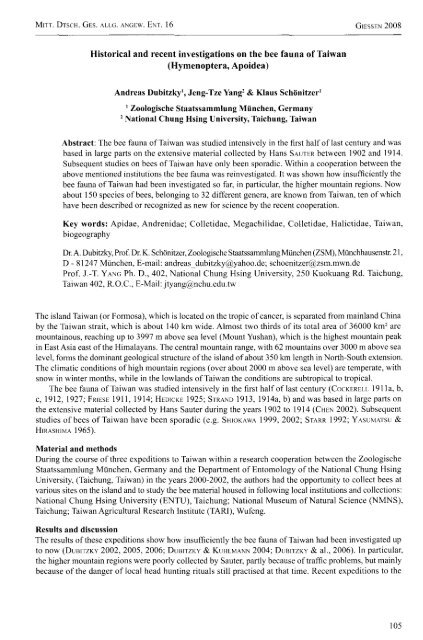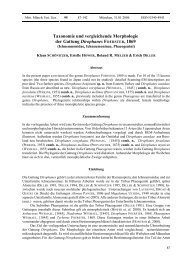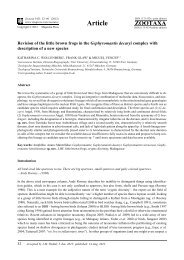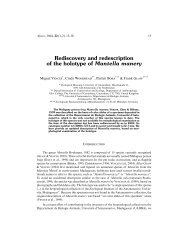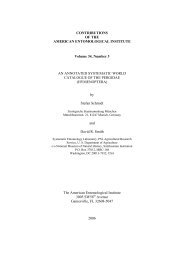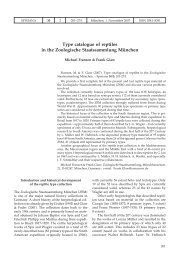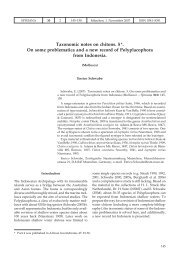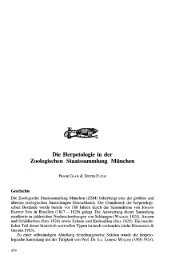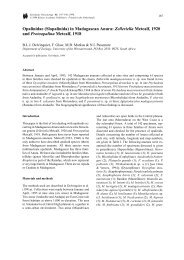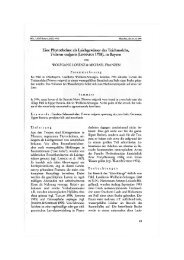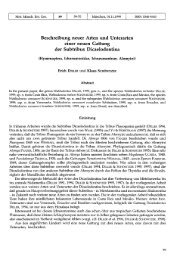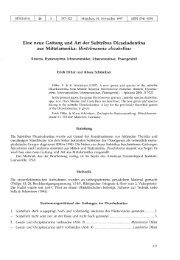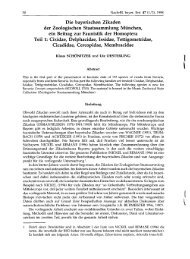Historical and recent investigations on the bee fauna of Taiwan ...
Historical and recent investigations on the bee fauna of Taiwan ...
Historical and recent investigations on the bee fauna of Taiwan ...
Create successful ePaper yourself
Turn your PDF publications into a flip-book with our unique Google optimized e-Paper software.
MITT. DTSCH. GES. ALLG. ANGEW. ENT. 16 GIESSEN 2008<str<strong>on</strong>g>Historical</str<strong>on</strong>g> <str<strong>on</strong>g>and</str<strong>on</strong>g> <str<strong>on</strong>g>recent</str<strong>on</strong>g> <str<strong>on</strong>g>investigati<strong>on</strong>s</str<strong>on</strong>g> <strong>on</strong> <strong>the</strong> <strong>bee</strong> <strong>fauna</strong> <strong>of</strong> <strong>Taiwan</strong>(Hymenoptera, Apoidea)Andreas Dubitzky 1 , Jeng-Tze Yang 2 & Klaus Sch<strong>on</strong>itzer 11 Zoologische Staatssanimlung Miinchen, Germany2 Nati<strong>on</strong>al Chung Hsing University, Taichung, <strong>Taiwan</strong>Abstract: The <strong>bee</strong> <strong>fauna</strong> <strong>of</strong> <strong>Taiwan</strong> was studied intensively in <strong>the</strong> first half <strong>of</strong> last century <str<strong>on</strong>g>and</str<strong>on</strong>g> wasbased in large parts <strong>on</strong> <strong>the</strong> extensive material collected by Hans SAUTER between 1902 <str<strong>on</strong>g>and</str<strong>on</strong>g> 1914.Subsequent studies <strong>on</strong> <strong>bee</strong>s <strong>of</strong> <strong>Taiwan</strong> have <strong>on</strong>ly <strong>bee</strong>n sporadic. Within a cooperati<strong>on</strong> between <strong>the</strong>above menti<strong>on</strong>ed instituti<strong>on</strong>s <strong>the</strong> <strong>bee</strong> <strong>fauna</strong> was reinvestigated. It was shown how insufficiently <strong>the</strong><strong>bee</strong> <strong>fauna</strong> <strong>of</strong> <strong>Taiwan</strong> had <strong>bee</strong>n investigated so far, in particular, <strong>the</strong> higher mountain regi<strong>on</strong>s. Nowabout 150 species <strong>of</strong> <strong>bee</strong>s, bel<strong>on</strong>ging to 32 different genera, are known from <strong>Taiwan</strong>, ten <strong>of</strong> whichhave <strong>bee</strong>n described or recognized as new for science by <strong>the</strong> <str<strong>on</strong>g>recent</str<strong>on</strong>g> cooperati<strong>on</strong>.Key words: Apidae, Andrenidae; Colletidae, Megachilidae, Colletidae, Halictidae, <strong>Taiwan</strong>,biogeographyDr. A. Dubitzky, Pr<strong>of</strong>. Dr. K. Sch<strong>on</strong>itzer, Zoologische Staatssammlung Munchen (ZSM), Miinchhausenstr. 21,D - 81247 Munchen, E-mail: <str<strong>on</strong>g>and</str<strong>on</strong>g>reas_dubitzky@yahoo.de; schoenitzer@zsm.mwn.dePr<strong>of</strong>. J.-T. YANG Ph. D., 402, Nati<strong>on</strong>al Chung Hsing University, 250 Kuokuang Rd. Taichung,<strong>Taiwan</strong> 402, R.O.C., E-Mail: jtyang@nchu.edu.twThe isl<str<strong>on</strong>g>and</str<strong>on</strong>g> <strong>Taiwan</strong> (or Formosa), which is located <strong>on</strong> <strong>the</strong> tropic <strong>of</strong> cancer, is separated from mainl<str<strong>on</strong>g>and</str<strong>on</strong>g> Chinaby <strong>the</strong> <strong>Taiwan</strong> strait, which is about 140 km wide. Almost two thirds <strong>of</strong> its total area <strong>of</strong> 36000 km 2 aremountainous, reaching up to 3997 m above sea level (Mount Yushan), which is <strong>the</strong> highest mountain peakin East Asia east <strong>of</strong> <strong>the</strong> Himalayans. The central mountain range, with 62 mountains over 3000 m above sealevel, forms <strong>the</strong> dominant geological structure <strong>of</strong> <strong>the</strong> isl<str<strong>on</strong>g>and</str<strong>on</strong>g> <strong>of</strong> about 350 km length in North-South extensi<strong>on</strong>.The climatic c<strong>on</strong>diti<strong>on</strong>s <strong>of</strong> high mountain regi<strong>on</strong>s (over about 2000 m above sea level) are temperate, withsnow in winter m<strong>on</strong>ths, while in <strong>the</strong> lowl<str<strong>on</strong>g>and</str<strong>on</strong>g>s <strong>of</strong> <strong>Taiwan</strong> <strong>the</strong> c<strong>on</strong>diti<strong>on</strong>s are subtropical to tropical.The <strong>bee</strong> <strong>fauna</strong> <strong>of</strong> <strong>Taiwan</strong> was studied intensively in <strong>the</strong> first half <strong>of</strong> last century (COCKERELL 1911a, b,c, 1912, 1927; FRIESE 1911, 1914; HEDICKE 1925; STRAND 1913, 1914a, b) <str<strong>on</strong>g>and</str<strong>on</strong>g> was based in large parts <strong>on</strong><strong>the</strong> extensive material collected by Hans Sauter during <strong>the</strong> years 1902 to 1914 (CHEN 2002). Subsequentstudies <strong>of</strong> <strong>bee</strong>s <strong>of</strong> <strong>Taiwan</strong> have <strong>bee</strong>n sporadic (e.g. SHIOKAWA 1999, 2002; STARR 1992; YASUMATSU &HIRASHIMA 1965).Material <str<strong>on</strong>g>and</str<strong>on</strong>g> methodsDuring <strong>the</strong> course <strong>of</strong> three expediti<strong>on</strong>s to <strong>Taiwan</strong> within a research cooperati<strong>on</strong> between <strong>the</strong> ZoologischeStaatssammlung Munchen, Germany <str<strong>on</strong>g>and</str<strong>on</strong>g> <strong>the</strong> Department <strong>of</strong> Entomology <strong>of</strong> <strong>the</strong> Nati<strong>on</strong>al Chung HsingUniversity, (Taichung, <strong>Taiwan</strong>) in <strong>the</strong> years 2000-2002, <strong>the</strong> authors had <strong>the</strong> opportunity to collect <strong>bee</strong>s atvarious sites <strong>on</strong> <strong>the</strong> isl<str<strong>on</strong>g>and</str<strong>on</strong>g> <str<strong>on</strong>g>and</str<strong>on</strong>g> to study <strong>the</strong> <strong>bee</strong> material housed in following local instituti<strong>on</strong>s <str<strong>on</strong>g>and</str<strong>on</strong>g> collecti<strong>on</strong>s:Nati<strong>on</strong>al Chung Hsing University (ENTU), Taichung; Nati<strong>on</strong>al Museum <strong>of</strong> Natural Science (NMNS),Taichung; <strong>Taiwan</strong> Agricultural Research Institute (TAR1), Wufeng.Results <str<strong>on</strong>g>and</str<strong>on</strong>g> discussi<strong>on</strong>The results <strong>of</strong> <strong>the</strong>se expediti<strong>on</strong>s show how insufficiently <strong>the</strong> <strong>bee</strong> <strong>fauna</strong> <strong>of</strong> <strong>Taiwan</strong> had <strong>bee</strong>n investigated upto now (DUBITZKY 2002, 2005, 2006; DUBITZKY & KUHLMANN 2004; DUBITZKY & al., 2006). In particular,<strong>the</strong> higher mountain regi<strong>on</strong>s were poorly collected by Sauter, partly because <strong>of</strong> traffic problems, but mainlybecause <strong>of</strong> <strong>the</strong> danger <strong>of</strong> local head hunting rituals still practised at that time. Recent expediti<strong>on</strong>s to <strong>the</strong>105
GIESSEN 2008 MITT. DTSCH. GES. ALLG. ANGEW. ENT. 16mountain regi<strong>on</strong>s <strong>the</strong>refore harvested valuable material <str<strong>on</strong>g>and</str<strong>on</strong>g> furnished interesting results, for example <strong>the</strong>first record <strong>of</strong> <strong>the</strong> genus Colletes <strong>on</strong> <strong>Taiwan</strong> (DUBITZKY & KUHLMANN 2004). A key to <strong>the</strong> genera <strong>of</strong> <strong>the</strong> <strong>bee</strong>sknown from <strong>Taiwan</strong> was presented <str<strong>on</strong>g>recent</str<strong>on</strong>g>ly (DUBITZKY & al. 2006).To date about 150 species <strong>of</strong> <strong>bee</strong>s, bel<strong>on</strong>ging to 32 different genera, are known from <strong>Taiwan</strong> (Tab. 1).While seven <strong>of</strong> <strong>the</strong>se genera are mainly distributed in <strong>the</strong> Palearctic regi<strong>on</strong>, 11 <strong>of</strong> <strong>the</strong>m are typical for <strong>the</strong>Oriental as well as for Palearctic regi<strong>on</strong> <str<strong>on</strong>g>and</str<strong>on</strong>g> 11 genera are primarily found in <strong>the</strong> Oriental regi<strong>on</strong>. The generaBathanthidium, Elaphropoda <str<strong>on</strong>g>and</str<strong>on</strong>g> Tetral<strong>on</strong>ioidella are restricted to <strong>the</strong> Oriental regi<strong>on</strong>.FamilyColletidaeAndrenidaeHalictidaeMegachilidaeApidaeGenusColletes LATREILLE (C. taiwanensis DUBITZKY & KUHLMANN)Hylaeus FABRICIUS (3)Andrena FABRICIUS (6)Halictus LATREILLE (H. aerarius SMITH)Lasioglossum Curtis (25)Lipotriches GERSTAECKER (2)Nomia LATREILLE (12)Nomioides SCHENCK (2)Patellapis FRIESE (P. formosicola BLUTHGEN)Sphecodes LATREILLE (3)Steganomus RITSEMA (S. taiwana HIRASHIMA)Bathanthidium ALFKEN (B. bifoveolatum (ALFKEN))Coelioxys LATREILLE (6)Euaspis GERSTAECKER (2)Heriades SPINOLA (H. sauteri COCKERELL)Lithurgus BERTHOLD (L. collaris SMITH)Megachile LATREILLE (25)Trachusa PANZER(2)Amegilla FRIESE (6)Apis LINNAEUS (2)Bombus LATREILLE (9)Braunsapis MICHENER (B. marginata (SMITH))Ceratina LATREILLE (10)Ctenoplectra KIRBY (2)Elaphropoda LIEFTINCK (E. taiwanica Wu)Habropoda SMITH (4)Nomada SCOPOLI (4)Tetral<strong>on</strong>ia SPINOLA (3)Tetral<strong>on</strong>ioidella STRAND (3)Thyreus PANZER (3)Trig<strong>on</strong>a JURINE (T. ventralis SMITH)Xylocopa LATREILLE (7)biogeographic regi<strong>on</strong>Tab.l: Bee families <str<strong>on</strong>g>and</str<strong>on</strong>g> genera recorded <strong>on</strong> <strong>Taiwan</strong> with number <strong>of</strong> species given in paren<strong>the</strong>ses or with name <strong>of</strong>species if <strong>on</strong>ly <strong>on</strong>e species occurs in <strong>Taiwan</strong>. Genera are listed in alphabetically order which does not reflect <strong>the</strong>systematic positi<strong>on</strong> <strong>of</strong> <strong>the</strong> genera within each family. The main distributi<strong>on</strong> <strong>of</strong> <strong>the</strong> genus (biogeographic regi<strong>on</strong>) isgiven in c<strong>on</strong>siderati<strong>on</strong> <strong>of</strong> <strong>the</strong> Old World without Africa as follows: O: genus with predominantly Oriental distributi<strong>on</strong>;O*: occurring in oriental regi<strong>on</strong> <strong>on</strong>ly; O/P: genus with Oriental <str<strong>on</strong>g>and</str<strong>on</strong>g> Palearctic distributi<strong>on</strong>; P: genus with predominantlyPalearctic distributi<strong>on</strong>.PPPO/PO/Poopopoo*O/PoO/PpO/PO/PO/PoO/PoO/Poo*opO/Po*O/Poo106
MITT. DTSCH. GES. ALLO. ANOEW. ENT. 16 GIESSEN 2008Ten species <strong>of</strong> <strong>bee</strong>s have <strong>bee</strong>n described or recognized as new for science by <strong>the</strong> <str<strong>on</strong>g>recent</str<strong>on</strong>g> research cooperati<strong>on</strong>.C<strong>on</strong>cerning <strong>the</strong> genus Andrena, <strong>of</strong> which <strong>on</strong>ly <strong>on</strong>e species was recorded for <strong>Taiwan</strong>, <strong>the</strong> total number <strong>of</strong>species increased up to six in <strong>the</strong> course <strong>of</strong> this study with four species being new to science (DUBITZKY 2002,2006). The nearest relatives <strong>of</strong> <strong>the</strong>se new species are interestingly found in <strong>the</strong> Palearctic <str<strong>on</strong>g>and</str<strong>on</strong>g> not in <strong>the</strong>Oriental regi<strong>on</strong>. This is because <strong>the</strong> new species are predominantly inhabiting <strong>the</strong> higher regi<strong>on</strong>s <strong>of</strong> <strong>Taiwan</strong>,which are generally more similar to <strong>the</strong> Palearctic regi<strong>on</strong> than <strong>the</strong> lower, more tropical parts <strong>of</strong> <strong>the</strong> isl<str<strong>on</strong>g>and</str<strong>on</strong>g>.The great differences in altitude found <strong>on</strong> <strong>Taiwan</strong> also seem to be important for speciati<strong>on</strong> processes withino<strong>the</strong>r <strong>bee</strong> genera as shown e. g. for Habropoda <str<strong>on</strong>g>and</str<strong>on</strong>g> Tetral<strong>on</strong>ioidella (DUBITZKY 2005).Several species were described within <strong>the</strong> genus Halictus, but <strong>the</strong>re is actually to date <strong>on</strong>ly <strong>on</strong>e speciesknown <strong>of</strong> this genus (s. 1. as seen by MICHENER <str<strong>on</strong>g>and</str<strong>on</strong>g> EBMER) from <strong>Taiwan</strong>, Halictus (Selad<strong>on</strong>ia) aerariusSMITH, 1873 which was described under <strong>the</strong> syn<strong>on</strong>ym Halictus leucopog<strong>on</strong> STRAND (EBMER 2006 <str<strong>on</strong>g>and</str<strong>on</strong>g> pers<strong>on</strong>alcommunicati<strong>on</strong>). Thanks to informati<strong>on</strong>s provided by EBMER (pers. com.) <strong>the</strong> list <strong>of</strong> halictide genera recordedfor <strong>Taiwan</strong> could be completed by <strong>the</strong> genus Patellapis, which is represented by <strong>the</strong> subgenus PachyhalictusCOCKERELL <strong>on</strong> <strong>Taiwan</strong>. Unfortunately this genus was not included in <strong>the</strong> key <strong>of</strong> <strong>bee</strong> genera <strong>of</strong> <strong>Taiwan</strong> whichhas <strong>bee</strong>n presented <str<strong>on</strong>g>recent</str<strong>on</strong>g>ly (DUBITZKY & al. 2006).Although <strong>the</strong> <strong>fauna</strong> <strong>of</strong> <strong>Taiwan</strong> is mostly assigned to <strong>the</strong> Oriental regi<strong>on</strong>, <strong>the</strong> results <strong>of</strong> this investigati<strong>on</strong>clearly support that <strong>the</strong> insects <strong>of</strong> <strong>the</strong> higher mountainous parts resemble more str<strong>on</strong>gly <strong>the</strong> Eastern Palearcticregi<strong>on</strong>. It is suggested that additi<strong>on</strong>al species <str<strong>on</strong>g>and</str<strong>on</strong>g> genera will be found in fur<strong>the</strong>r <str<strong>on</strong>g>investigati<strong>on</strong>s</str<strong>on</strong>g>, especiallyin <strong>the</strong> mountainous parts <strong>of</strong> <strong>the</strong> isl<str<strong>on</strong>g>and</str<strong>on</strong>g>.AcknowledgementThis investigati<strong>on</strong> was supported by DAAD <str<strong>on</strong>g>and</str<strong>on</strong>g> NSF (PPP Project D/0039914). Fur<strong>the</strong>rmore we thank toMay-Ling Chan, Nati<strong>on</strong>al Museum <strong>of</strong> Natural Science, Taichung <str<strong>on</strong>g>and</str<strong>on</strong>g> Hsien-Tzung Shih, <strong>Taiwan</strong> AgriculturalResearch Institute, Council <strong>of</strong> Agriculture, Wufeng, Taichung, for good cooperati<strong>on</strong> <str<strong>on</strong>g>and</str<strong>on</strong>g> <strong>the</strong> possibility tolend material. We also thank to A. W. Ebmer, Puchenau, Austria, for very helpful informati<strong>on</strong> <str<strong>on</strong>g>and</str<strong>on</strong>g> literature<strong>on</strong> Halictinae as well as for <strong>the</strong> informati<strong>on</strong> <strong>on</strong> <strong>the</strong> existence <strong>of</strong> <strong>the</strong> genus Patellapis <strong>on</strong> <strong>Taiwan</strong>.ReferencesCHEN, K.-M. (2002): Hans SAUTER (1871-1943). -Taipeh heute, 15(6): 58-59COCKERELL, T. D. A. (191 la): The humble <strong>bee</strong>s <strong>of</strong> Formosa. -The Entomologist, 44(574): 100-102COCKERELL, T. D. A. (1911b): Descripti<strong>on</strong>s <str<strong>on</strong>g>and</str<strong>on</strong>g> Records <strong>of</strong> Bees, XXXIV. -Ann. Mag. Nat. Hist., 7(8):225-236COCKERELL, T. D. A. (1911c): Some <strong>bee</strong>s from Formosa I. - Entomologist, 44: 340-343COCKERELL, T. D. A. (1912): Some <strong>bee</strong>s from Formosa II. - Entomologist, 45: 9-13COCKERELL, T. D. A. (1927): Some <strong>bee</strong>s principally from Formosa <str<strong>on</strong>g>and</str<strong>on</strong>g> China. -Am. Mus. Nov., 274: 1-16DUBITZKY, A. (2002): A new s<str<strong>on</strong>g>and</str<strong>on</strong>g><strong>bee</strong> from <strong>the</strong> mountain regi<strong>on</strong> <strong>of</strong> central <strong>Taiwan</strong>: Andrena taiwanellaspec. nov. (Insecta, Hymenoptera, Andrenidae). - Spixiana, 25: 69-77DUBITZKY, A. (2005): Studies in phylogeny <str<strong>on</strong>g>and</str<strong>on</strong>g> biosystematics <strong>of</strong> <strong>bee</strong>s: The <strong>bee</strong> genus Andrena (Andrenidae)<str<strong>on</strong>g>and</str<strong>on</strong>g> <strong>the</strong> tribe Anthophorini (Apidae) (Insecta: Hymenoptera: Apoidea). - PhD dissertati<strong>on</strong>, Department<strong>of</strong> Biology <strong>of</strong> <strong>the</strong> Ludwig-Maximilians-University, Munich, 214 pp.DUBITZKY, A. (2006): New palearctic species <strong>of</strong> <strong>the</strong> <strong>bee</strong> genus Andrena (Insecta: Hymenoptera: Andrenidae). -Zootaxa, 1284: 1-27DUBITZKY, A. & M. KUHLMANN (2004): First record <strong>of</strong> <strong>the</strong> <strong>bee</strong> genus Colletes for <strong>Taiwan</strong> with descripti<strong>on</strong> <strong>of</strong>a new species (Hymenoptera, Apoidea, Colletidae). - Dtsch. ent. Z., 51: 271-278.DUBITZKY, A., J.-T. YANG & K. SCHONITZER (2006): The <strong>bee</strong> <strong>fauna</strong> (Hymenoptera: Apoidea) <strong>of</strong> <strong>Taiwan</strong>. -Beitr. Hymenop.-Tagung Stuttgart 2006: 42-46EBMER A.W. (2006) Daten zur Aculeaten-Fauna der Ussuri-Regi<strong>on</strong> unter Berticksichtigung der angrenzendenGebiete - 2. Arten der Gattung Halictus, Lasioglossum, Dufurea, Macropis aus dem Lazovski Zapovednik -Naturreservat Laso (Insecta: Hymenoptera: Apoidea: Halictidae, Melittidae). - Linzer biol. Beitr. 38,541-593FRIESE, H. (1911): Neue Bienenarten v<strong>on</strong> Formosa und aus China (Kant<strong>on</strong>). - Verh. zool.-bot. Ges. Wien, 59:123-128107
GIESSEN 2008 MITT. DTSCH. GES. ALLG. ANOEW. ENT. 16FRIESE, H. (1914): Neue Bienenarten der orientalischen Regi<strong>on</strong>. - Dtsch. ent. Z., 1914: 320-324HEDICKE, H. (1925): Die Megachile-Arten der Insel Formosa. (Hym.) (1. Beitrag zur Kenntnis orientalischerApiden). - Dtsch. ent. Z., 1925 (5): 353-366SHIOKAWA, M. (1999): Two new subspecies <strong>of</strong> a small carpenter <strong>bee</strong>, Ceratina okinawana from East Asia. -Jap. J. Syst. Ent., 5(2): 259-266SHIOKAWA, M. (2002): Tax<strong>on</strong>omic notes <strong>on</strong> <strong>the</strong> bryanti-group <strong>of</strong> <strong>the</strong> <strong>bee</strong> genus Ceratina from sou<strong>the</strong>ast China(Hymenoptera: Apidae). - Ent. Sci., 5(4): 411-419STARR, C. K. (1992): The bumble <strong>bee</strong>s (Hymenoptera: Apidae) <strong>of</strong> <strong>Taiwan</strong>. - Bull. Nat. Museum NaturalScience, 1992(3): 139-157STRAND, E. (1913): H. SAUTER'S Formosa Ausbeute: Apidae I. - Suppl. Ent., 2: 23-67STRAND, E. (1914a): H. SAUTER'S Formosa Ausbeute: Apidae II. -Arch. Naturg., 79A (12): 147-171STRAND, E. (1914b): H. SAUTER'S Formosa Ausbeute: Apidae III.-Arch. Naturg., 80A(l): 136-144YASUMATSU, K. & Y HIRASHIMA (1965): Two new species <strong>of</strong> Megachile from <strong>Taiwan</strong> (Hymenoptera, Apoidea).-K<strong>on</strong>tyu, 33(3): 373-384108


